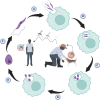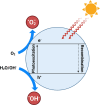Innovating Leishmaniasis Treatment: A Critical Chemist's Review of Inorganic Nanomaterials
- PMID: 39001837
- PMCID: PMC11320585
- DOI: 10.1021/acsinfecdis.4c00231
Innovating Leishmaniasis Treatment: A Critical Chemist's Review of Inorganic Nanomaterials
Abstract
Leishmaniasis, a critical Neglected Tropical Disease caused by Leishmania protozoa, represents a significant global health risk, particularly in resource-limited regions. Conventional treatments are effective but suffer from serious limitations, such as toxicity, prolonged treatment courses, and rising drug resistance. Herein, we highlight the potential of inorganic nanomaterials as an innovative approach to enhance Leishmaniasis therapy, aligning with the One Health concept by considering these treatments' environmental, veterinary, and public health impacts. By leveraging the adjustable properties of these nanomaterials─including size, shape, and surface charge, tailored treatments for various diseases can be developed that are less harmful to the environment and nontarget species. We review recent advances in metal-, oxide-, and carbon-based nanomaterials for combating Leishmaniasis, examining their mechanisms of action and their dual use as standalone treatments or drug delivery systems. Our analysis highlights a promising yet underexplored frontier in employing these materials for more holistic and effective disease management.
Keywords: Leishmaniasis; carbon-based materials; drug delivery systems; inorganic nanomaterials; metallic nanoparticles; neglected tropical diseases; oxide nanoparticles.
Conflict of interest statement
The authors declare no competing financial interest.
Figures








References
-
- Ilbeigi K.; Barata C.; Barbosa J.; Bertram M. G.; Caljon G.; Costi M. P.; Kroll A.; Margiotta-Casaluci L.; Thoré E. S. J.; Bundschuh M. Assessing Environmental Risks during the Drug Development Process for Parasitic Vector-Borne Diseases: A Critical Reflection. ACS Infect Dis 2024, 10 (4), 1026–1033. 10.1021/acsinfecdis.4c00131. - DOI - PMC - PubMed
-
- WHO . Ending the Neglect to attain the Sustainable Goals: A Road Map for Neglected Diseases 2021–2030; 2020.
Publication types
MeSH terms
Substances
LinkOut - more resources
Full Text Sources
Medical

